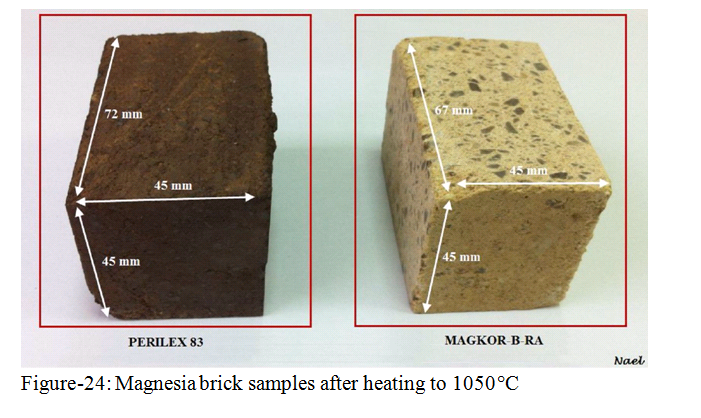Contents
click here to Download the Most Important 13 Books in Cement Industry
click here to Download the Most Important 13 Books in Cement Industry
How can hydration of magnesia bricks be test throughout its life cycle?
By: Nael Shabana qatar.cement@yahoo.com
The easiest ways to test the hydration of magnesia bricks are summarized below as the following:
- The extent of hydration in magnesia bricks can be tested by light tapping with a metallic hammer. A metallic sound is an indication that the brick has not been hydrated and is usable, whereas a dull sound indicates that the brick has been hydrated and is unusable.
- A white coating on the external face of a brick which is associated with brittleness, loose structure and cracking, is a sign of hydration. The white outside layer may not adversely affect the serviceability of the bricks, but if the white Mg(OH)2 continues to the inside of the brick, the degree of hydration is advanced. Testing for deeper brick hydration is a destructive process, since the brick must be broken to perform a visual inspection.
- The best and exact degree of hydration can be determined by loss in ignition test. This is done by drying brick pieces at 110°C for four hours and measuring the weight. The dried brick is then placed in a furnace and heated for 12 hours at 1050°C, after which the weight is measured again. The difference in weight between the dry specimen and the furnace-heated specimen is an indication of the degree of hydration . Ignition loss of a not hydrated (new) magnesia-chrome brick is approximately 0.2%.
- Bricks with (0.2% to 0.6%) ignition loss; don’t damage during heating-up and can be used.
- Bricks with (0.6% to 1.0%) ignition loss; indicate that there is danger of destruction during heating-up .
- Bricks with more than 1.0 % ignition loss; indicate that the serviceability of bricks is restricted .
Example: (Loss on Ignition Test)
Two samples of magnesia bricks (figure-24) were heated in the furnace up to 110°C & then to 1050°C. Weight of the samples after heating and ignition loss measurement were noted and recorded:
Sample–1: MAGKOR-B-RA [fired chromite ore free magnesia spinel]
- Magnesia content: 92-93%
- Initial Weight: 388.7 grams
- Weight after heating at 110°C for 4 hours: 387.3 grams
- Weight after heating at 1050°C for 12 hours: 368.6 grams Loss on Ignition = (387.3 – 368.6) / 387.3 = 0.483 %
Sample–2: PERILEX 83 [magnesia chromite]
- Magnesia content: 81 – 85%
- Initial Weight: 405.8 grams
- Weight after heating at 110 °C for 4 hours: 404.2 grams
- Weight after heating at 1050 °C for 12 hours: 403.3 grams Loss in Ignition = (404.2 – 403.3) / 404.2 = 0.022 %
